| |
From Mass to Social Media: Governing Mental Health and Depression in the Digital Age
De la masa a los medios de comunicación social: gobernar la salud mental y la depresión en la era digital
Riki Thompson
University of Washington Tacoma
(UNITED STATES OF AMERICA)
rikitiki@uw.edu
Rich Furman
University of Washington Tacoma
(UNITED STATES OF AMERICA)
rcfurman@uw.edu
Recibido: 17/10/2017
Revisado: 18/10/2017
Aprobado: 10/11/2017
ABSTRACT
Over the past century, mental health disorders have become an area of concern for maintaining a “productive” population, as attention has shifted to endemics that slowly diminish the capacity to live a long and productive life and the care of society depends upon disciplinary technologies that aim to educate and manage people about health and self-care. People deemed as a burden on the state, such as the mentally ill, are commonly objects of governmentality (Foucault, 1988, 2003, 2011). In this study of the U.S. National Institute for Mental Health media campaign (2003-2013), we explore the intersection between institutional discourse, narratives of personal experience, and media forms. This research contributes to the burgeoning field of Digital Discourse Studies to provide improved tools for sociolinguistic and discourse-analytic research in new media contexts by combining governmentality theory, multimodality studies, and CDA methodologies that serve new media environments. Through this case study we illustrate how institutions operationalize virtual visual synthetic personalization to reproduce institutional discourses in the service of governing, and we extend upon governmentality, introducing technologies of sociality as a disciplinary technology brought on by the affordances of social media.
Keywords: Critical discourse analysis. Governmentality. Narrative. Social media. Mental health. Gender.
RESUMEN
Durante el siglo pasado, los trastornos de la salud mental se han convertido en un área de preocupación para mantener una población "productiva", ya que la atención se ha desplazado hacia endemismos que lentamente disminuyen la capacidad de vivir una vida larga y productiva y el cuidado de la sociedad depende de tecnologías disciplinarias que Tienen como objetivo educar y administrar a las personas sobre la salud y el autocuidado. Las personas consideradas como una carga para el estado, como los enfermos mentales, son comúnmente objetos de la gubernamentalidad (Foucault, 1988, 2003, 2011). En este estudio de la campaña mediática del Instituto Nacional de Salud Mental de los Estados Unidos (2003-2013), exploramos la intersección entre el discurso institucional, las narrativas de la experiencia personal y las formas de los medios de comunicación. Esta investigación contribuye al floreciente campo de los Estudios del Discurso Digital para proporcionar herramientas mejoradas para la investigación sociolingüística y discursiva-analítica en contextos de nuevos medios combinando teoría de la gobiernoalidad, estudios de multimodalidad y metodologías CDA que sirven a nuevos entornos de medios. A través de este estudio de caso ilustramos cómo las instituciones operacionalizan la personalización sintética virtual visual para reproducir discursos institucionales al servicio del gobierno, y extendemos la gobernabilidad, introduciendo tecnologías de la socialidad como una tecnología disciplinaria provocada por las affordances de las redes socials.
Palabras clave: Análisis crítico del discurso. Gobierno. Narrativa. Medios sociales. Salud mental. Género.
1. Introduction
The need to nurture the emotional self, not just the physical self, has long concerned those in the business of governing people. The United States Declaration of Independence (1776), which states that citizens have an unalienable right to “life, liberty, and the pursuit of happiness,” illustrates the belief that caring for a society includes attention to the emotional well-being of its people. [1] Over the past century, mental health disorders have become an area of concern for maintaining a productive population whereas past concerns to combat deadly epidemics have been replaced in the industrialized world with attention to endemics that slowly diminish the capacity to live a long and productive life. People deemed as a burden on the state, such as the mentally ill, tend to become the focus of governmentality efforts (Foucault, 1988, 2011), a cycle by which government and the people collaborate for the shared goal of a better society.
______Global and local health organizations report that depression is prevalent and extensive. According to the World Health Organization, depression is one of the most common psychiatric (mental) disorders and a leading cause of disability. Currently, depression ranks as the second leading contributor to the global burden of disease for men and women aged 15-44 and is estimated to expand to include all age groups by 2020 (WHO, 2011). So prevalent, depression has been referred to as the common cold of mental health concerns (Turnbull, 1991). While not always receiving equal attention and funding as physical health concerns from governmental bodies, agencies have identified depression as a major public health concern and have taken a vested interest in educating citizens about how to care for the self in response (Richards, Ryan, McCabe, Groom, & Hickie, 2011).
______Although statistics report women suffer depression more than men by a ratio of 2:1, some reports are as high as 4:1 (Lafrance, 2007; Ussher, 2010), concerns about the large numbers of men who remain unaware of (or untreated for) mental health disorders has gained recent attention. Brownhill et al. (2005) argue that “there is a risk that we may be overpathologizing women and, at the same time, underestimating men’s ‘unique pain’ of depression” because we take “silence” as an indicator of health rather than internalized feelings (921). Masculinity studies have shown that men tend to endure emotional distress in silence when they have internalized ideological scripts of emotional control that suggest men should be tough and stoic, avoiding emotional displays that may be deemed as effeminate (Burns & Mahalik, 2011; Mahalik, Good, & Englar-Carlson, 2003).
______Government initiatives to raise public awareness about social problems have long been utilized by the state to educate citizens, with Public Service Announcement (PSA) [2] campaigns that rely on a variety of rhetorical appeals and media forms to disseminate the message. In 2003 the National Institute of Mental Health (NIMH) developed the Real Men. Real Depression (RMRD) campaign [3], the “first formal public effort to raise awareness about the topic” of men’s depression in the United States (NIMH, 2013). NIMH relied heavily on traditional mass media, including eleven PSAs created for television, seven for radio, print-based PSAs for popular magazines, and a pamphlet designed for health care providers. Documentary-style first-person narrative vignettes were edited into various forms for video, audio, and print PSAs [4]. NIMH also created a web presence, which included information about depression, resources for seeking help, and links to video and audio PSAs. In 2005, the campaign expanded its reach to Latino communities by adding materials in Spanish, and in 2013, NIMH updated the campaign, renaming it Men and Depression (MAD), updating website and print materials, and integrating social media to circulate videos and disseminate the message.
______The outreach effort generated 14 million hits to the web site and nearly 5,000 emails and phone calls to the information hotline (NIMH, 2013). NIMH distributed nearly one million copies of resources to interested people and organizations and reported “the campaign ha[d] surpassed agency expectations for dissemination and visibility. The initiative’s TV public service announcements (PSAs) alone have been estimated to reach 34 million people, with another 8 million visitors to the web site” (Rochlen, Whilde, & Hoyer, 2005, p. 186). The emergence of new media has altered the way in which mental health is communicated, such that the one-to-many outreach of traditional mass mediated public service campaigns has been replaced by a many-to-many circulation. Campaigns such as this are not just a “public service” but rather a complex network of techniques and practices aimed at governing the conduct of individuals and populations. The reach and enduring presence of this campaign, coupled with its benevolence and expansion into online socially mediated spaces makes this an important case study to understand the role of new media in efforts to govern society, influence ideology circulation, and specifically, shifting notions of mental health.
2. Theoretical Foundations
Social theorist Michele Foucault has spoken extensively on how governmental bodies manage populations through a variety of means; through disciplinary technologies, others are made “docile” so that they “may be subjected, used, transformed and improved” (1977, p. 136) for the “good” of society. Technologies of the self, on the other hand, are enacted when individuals internalize disciplinary technologies and engage in practices to improve themselves (Foucault, 1988, p. 18). By educating citizens that personal inaction results in threats to quality of life (and early mortality), government agencies teach and encourage individuals to engage in self-management practices to maintain a “productive” population. It is this point of “contact between the disciplinary technologies of domination of others and those of the self” (Foucault, 1988, p. 19) where governmentality exists. Thus, governmentality is a cycle of collecting data, tracking inefficiencies, and educating citizens to optimize the self in service of attaining a healthy, productive citizenry. Part of our task is to extend Foucault’s theory of governmentality (Foucault, 2003; Foucault, Burchell, Gordon, & Miller, 1991) to consider the role of new media in the caring for society. We argue that sociality technologies serve as another form of disciplinary power at play in the digital age, and demonstrate how one might apply this new concept to analyze new media discourse through a case study of a mental health public service campaign.
______With the evolution of media and digital technologies “texts are no longer just written, but ‘designed’ and multimodally articulated” (Kress and Van Leeuwen, 1998), thus creating new challenges for research. Scholars have taken innovative approaches to analyze discourse, adapting traditional approaches originally developed for written and conversation-based texts to examine ideology in social media contexts (Wodak and Wright, 2006; Mautner, 2005) and stories of personal experience in online contexts (Hoffman 2010, Page 2012, Vasquez 2014, Thompson 2012, Georgakopoulou 2013). Others have set out to define the field and call for theories and tools that better fit the digital landscape. Thurlow & Mroczek identify New Media Sociolinguistics (NMS) as the umbrella for research that explores the intersections between discourse, technology, multim0dality, and ideology (Thurlow & Mroczek, 2011, p. xix) whereas others have used the term Multimodal Critical Discourse Analysis (MCDA) to frame this sort of work (Machin, 2016). Unger (2012) argues that “Critical Discourse Studies (CDS) is advantageously placed, as a loose, adaptable theoretical approach rather than a rigid methodological framework, to investigate these new contexts, but it requires new tools to fully realise its potential.” Our research contributes to the burgeoning field of Digital Discourse Studies to provide improved tools for sociolinguistic and discourse-analytic research in new media contexts by combining governmentality theory, multimodality studies, and CDA methodologies that serve new media environments. Through this case study we illustrate how social media provides affordances for institutions to operationalize virtual visual synthetic personalization to reproduce institutional discourses. Furthermore, we expand upon governmentality theory, introducing sociality technologies as a new disciplinary technology that allows for greater and wider dissemination of institutional discourses intended to govern society through social media affordances.
3. Method
This case study is presented in three parts to demonstrate how discourse and new media (re)produce ideology about depression and gender to govern society. We focused on how men’s depression is discursively constructed at the institutional, individual, and technological level. We begin our analysis by focusing on the institutional discourse level, demonstrating how NIMH exercises technologies of power upon citizens through defining men’s depression as public health problem and educating people about how to care for the self (and the social order). Next, we show how individuals exercise technologies of the self, with “real men” self-identifying as members of the troubled population who share experiences of struggle, help-seeking, and self-management. Finally, we demonstrate how the integration of new media technology into traditionally mass mediated public service campaigns extends the reach of disciplinary power with technologies of sociality providing a many-to-many peer-driven branch of governmentality.
4. Technologies of power: Disciplining men’s depression
Effective messaging is vital to persuade citizens to take action in the face of a health crisis, especially when the public holds a predisposition that the threat is low or non-existent. Public education materials play an important role in discursively constructing mental health disorders as a threat in need of attention. Once identified by the state as an obstacle to longevity and productive citizenry, depression can be placed in the context of governmentality and mobilized as a project to be managed by everyone involved. Data about frequency and ubiquity of mental illness allow the state to create a sense of distress and a need to take action. The construction of depression as an epidemic, linguistically, numerically, and visually, has the potential to generate concern about behaviors, moods, and indicators of mental illness in self and others, especially when used in conjunction with excessive quantitative statistics, which have been said to instill a sort of “statistical panic” that can be used to (re)produce social anxieties (Thurlow, 2006) within the population.
______Statistics, alarmist language, and visually semiotic cues set the tone of crisis on the website and print-based materials. On the opening page of the PSA website (“Depression in Men”), men’s depression is constructed as a prevalent, widespread, physical disease that requires intervention (Figure 1). Quantifying depression as a problem faced by “more than 6 million men” escalates anxiety by making it common. Moreover, the use of bold face type and the geographic concentration of millions of cases “in American alone” further intensifies the construction of the disease as globally ubiquitous—a modern day epidemic. Even though NIMH tells readers that some people are more vulnerable due to family history, external stressors, and co-existing medical conditions, the primary message is that anyone can get depression. Regardless of support system or economic and social status, anyone can catch the disease, deepening the sense of panic about the epidemic proportions of the illness.
Figure 1
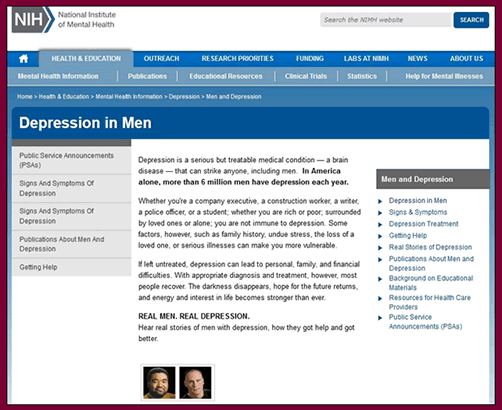
Figure 1: “DEPRESSION IN MEN” WEBPAGE (NIMH 2013)
Recovered from: http://www.nimh.nih.gov/health/topics/depression/men-and-depression/depression-in-men.shtml
When messages for a mass audience are contrived to give individuals the feel that they are being personally spoken to synthetic personalization is at work (Fairclough, 1989). When visual semiotic resources and web design are utilized to achieve similar rhetorical purposes, virtual visual synthetic personalization is at play as institutional voices are elided when personal discourses befriend the interlocutor (Thompson, 2012). This sort of linguistic synthetic personalization can be seen in print pamphlets and web pages as literary devices are employed to create intimacy with the audience. First person point of view lets audience members see the world through the view of the character or speaker by using I/me/my/mine whereas second person hooks the reader by speaking directly to them with you/your. Third person point of view, on the other hand, creates distance and provides the sense of objectivity. Third person is the preferred point of view for scientific writing, which makes it all the more interesting to see medical communication materials employing non-traditional discourse strategies for messaging.
______Throughout the campaign, the literary device of second person point of view is used to speak directly to readers. The introduction to depression on the NIMH website asks questions of readers:
"Are you tired and irritable all the time? Have you lost interest in your work, family, or hobbies? Are you having trouble sleeping and feeling angry or aggressive, sad, or worthless? Have you been feeling like this for weeks or months?” (Figure 1).
On the original print pamphlet (Figure 2), four of the six paragraphs used to provide context about depression and help-seeking use second person point of view, claiming that depression "affects how you eat and sleep”, "it alters your self-perceptions", and "changes the way you think and feel." A couple of paragraphs use third person objective to explain obstacles to help-seeking and treatment options: “The feelings and behaviors that are part of depression can hinder a person’s ability to seek help” and “Treatment choice will depend on the patient’s diagnosis.” To close the social distance created through third person, the final paragraph returns to second person, telling the reader "if you're feeling depressed, tell somebody about your symptoms." The updated pamphlet uses a similar synthetic personalization formula of beginning and closing with second person point of view that speaks directly to readers coupled with third person objective language about depression, symptoms, and treatment in the middle. Visual synthetic personalization is operationalized though images of relatable people gazing back at viewers, contriving familiarity and demanding engagement. Across this mass mediated and digitally mediated campaign, videos and images of “real men” gazing back at viewers demand engagement from viewers and close the social distance as these men serve as icons of managed-depression.
Figure 2
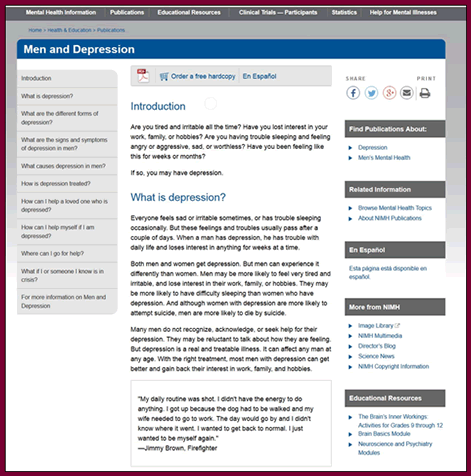
Figure 2: "DEFINING DEPRESSION" WEBPAGE (NIMH 2013)
Recovered from: http://www.nimh.nih.gov/health/publications/men-and-depression/index.shtml
This campaign explicitly frames depression as a problem for society at large, shifting the gendered rhetoric about depression as a women’s issue to make space for a portion of the population that has remained largely unaccounted for. Challenging long-standing discourses around depression, NIMH questions whether gender is indicative of higher incidence of depression or whether gender is actually linked to awareness and acknowledgment of symptoms, thereby inflating statistics that women suffer at greater rates than men. Campaign materials claims that insufficient data exists to verify “if depression is truly less common among men, or if men are just less likely than women to recognize, acknowledge, and seek help for depression” (NIMH, 2009). This concern is supported by many studies that demonstrate that men too frequently are unaware that their symptoms represent significant health concerns, or due to their needing to be perceived as strong and masculine, simply ignore them (Addis, 2008; Courtenay, 2003). Brownhill et al. (2005) suggest that depression in men may remain hidden or overlooked on account of traditional notions of masculinity that encourage men to minimize or internalize emotional distress and point out that gender differences related to depression are not in the experience so much as in the expression of the disorder. Santiago-Menendez & Campbell (2013) suggest that this internalization of emotions begins early in life through socialization that discourages emotional expression to promote conformity with traditional norms of masculinity that favor stoicism, restrictive emotionality, and reluctance to disclose feelings.
______Marking men’s depression as a serious threat to life and longevity, constructs the mental health disorder as a crisis in need of governing because statistics show that men are more likely to act out aggressively and take their own life.
Both men and women get depression. But men can experience it differently than women. Men may be more likely to feel very tired and irritable, and lose interest in their work, family, or hobbies. They may be more likely to have difficulty sleeping than women who have depression. And although women with depression are more likely to attempt suicide, men are more likely to die by suicide. (NIMH, 2013)
Statistics listed on the original website show that while women attempt suicide more often than men, a significantly higher percent of men actually commit suicide as result of depression (NIMH, 2003). That is, when men do attempt suicide, aspects of their gender role socialization make the attempts far more lethal, demonstrating the need to understand depression as being “gendered” for both men and women (Furman, 2010). Men’s depression is constructed as a previously unrecognized epidemic that needs urgent attention. Society is put on alert that all aspects of a man’s life can be adversely affected if depression is ignored. This approach is in line with research studies that examine men’s depression and suicide to develop gender-sensitive health services.
______In addition to data collection, expert knowledge is another primary tool of biopolitics (Foucault, 2003, p. 243). The institutional voice of NIMH and the genre of the “public service” announcement, with a humanitarian purpose to educate and provide resources, grant authority to the message. To further legitimize depression via experts who wield power/knowledge, depression is discursively legitimatized as a scientifically recognized medical condition by placing biological factors (genes, brain chemistry and hormones) first on the list of causes of depression; scientific discourse is placed in the primary position and external environmental conditions, such as stress, are given less prominence (Figure 2). Medical terminology of “diagnosis and treatment” legitimize the disease model, placing depression within a physical medical discourse rather than the psychotherapeutic discourse. In her research in the intersection of governmentality and self-help, Rimke (2000) points out that “In the domain of the self, one needs knowledge or information about the self for purposes of assessment and judgement” (68). Through questionnaires and surveys, individuals glean information about the self that fits within categories of representations of wellness and disorder.
5. Technologies of the self: Managing self-care
Since the focus of governmentality is longevity and productivity of the population, anything that interferes with this endeavor is deemed to be an obstacle to optimal health and happiness. An analysis of the story vignettes created for campaign literature demonstrates how individuals exercise technologies of the self—the second branch of governmentality—to
effect by their own means or with the help of others a certain number of operations on their own bodies and souls, thoughts, conduct, and ways of being, so as to transform themselves in order to attain a certain state of happiness, purity, wisdom, perfection, or immortality (Foucault, 1988, p. 18).
Thus, as “real men” take on the role of “expert patients” (Fox & Ward, 2006) they serve both as disciplined consumers and (re)producers of a discourse of power that teaches others how to recognize the problem and self-manage. The versions of men’s stories circulated on campaign materials further the agenda of NIMH to govern citizens through the modeling of successful self-disciplining.
______In late-modernity, the non-productive man creates a public health problem in that traditional masculinity discourse suggests that real men are active, able-bodied, and capable of containing emotional distress in the face of adversity. The NIMH campaign confronts the discourse of the productive member of society and problematicizes it through narrative accounts of men living with depression. Depression becomes an obstacle to productivity because of the debilitating effects on the body and the mind. For Rene Ruballo and Jimmy Brown, depression is framed as getting in the way of participating in life as they once knew it. Ruballo laments his inability to be a good dad, saying that when he suffered from depression he “didn't want to do anything” and
lost interest with the kids and the things that we used to do [as a family]” (Figure 3). Similarly, Jimmy Brown describes depression as a force that steals motivation and energy to that point that getting out of bed became a challenge (Figure 4), saying that “the day would go by and I didn’t know where it went (Figure 5).
Figure 3
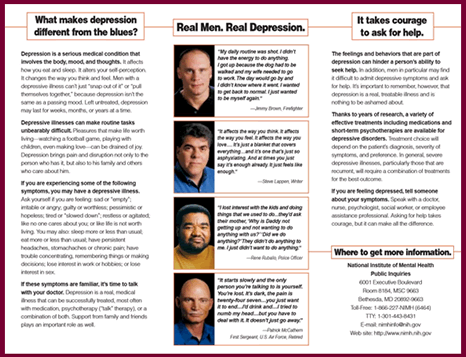
Figure 3: “REAL MEN, REAL DEPRESSION” PRINT PAMPHLET (2003)
Recovered from: http://www.nimh.nih.gov/health/publications/men-and-depression/men-and-depression_142046.pdf
Figure 4

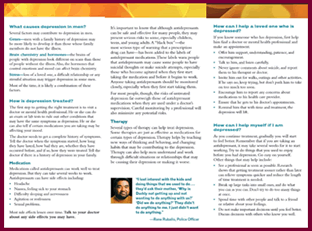
Figure 4: “MEN AND DEPRESSION” PRINT PAMPHLET (2013)
Recovered from: http://www.nimh.nih.gov/health/publications/men-and-depression/men-and-depression_142046.pdf
Figure5
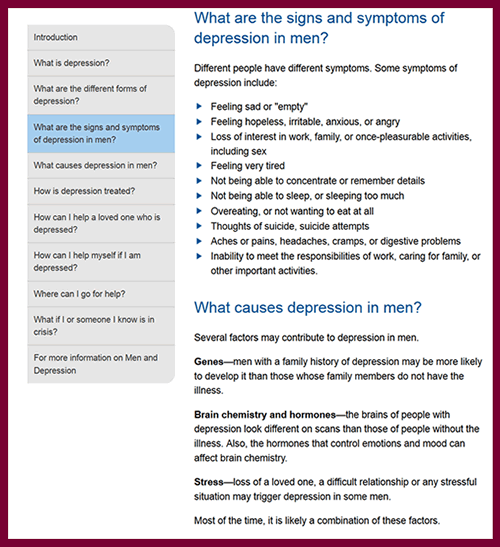
Figure 5: “WHAT ARE THE SIGNS AND SYMPTOMS OF DEPRESSION?” WEBPAGE (2013)
Recovered from: http://www.nimh.nih.gov/health/topics/depression/men-and-depression/signs-and-symptoms-of-depression/index.shtml
In some stories, depression is not merely presented as an obstacle to productivity, but rather a health crisis requiring intervention. The greatest threat to life and longevity, suicide, is discussed by a number of men in their narratives of dealing with depression. Bill Maruyama talks about what makes men give up and consider ending their life, saying:
______You lose your dreams and you lose your hopes and that’s when I think people then begin to give up and say that the only thing left for me is to end this pain and the only way I know how to end this pain is to commit suicide. (Figure 6)
Figure 6

Figure 6: RENE RUBALLO "I LOST INTEREST WITH THE KIDS AND DOING THE THINGS WE USED TO DO...YOU KNOW, THAT FAMILIES DO" TV PSA Recovered from: https://youtu.be/xDyhuPdXfYk?list=PLV9WJDAawyhbo5HInSxkRqTgwM3obv0iz
Paul Gottlieb tells a story of reckless behavior that reflected a lack of concern for his own life:
I never really tried to commit suicide, but I came awful close because I used to play matador with buses, you know, I would walk out into the traffic of New York City, no reference to traffic lights, red or green, almost hoping I would get knocked down. (Figure 7)
Figure 7

Figure 7: JIMMY BROWN "MANY DAYS I JUST DIDN'T WANT TO GET OUT OF BED" TV PSA
Recovered from: https://youtu.be/JurKzyNPzT0?list=PLV9WJDAawyhbo5HInSxkRqTgwM3obv0iz
The stereotypical big, strong, emotionally contained man is set up and then knocked down by counter-narratives (Lyotard, 1984) of real men that describe lived experiences in conflict with expected notions of traditional masculinity and argue for a new masculinity. Campaign materials that include job titles under each man’s name implicitly signal productivity while their accounts of living with depression explicitly describe the negative effects of mental illness on productivity. In his testimonial, Jimmy Brown, a New York City Firefighter, contextualizes the productivity paradox within specific occupations that require high levels of physical and emotional resiliency regardless of high levels of exposure to emotionally distressing stimuli. He points to a problem of both work culture and public perception, arguing that “Fire service, police service; it’s an entirely macho atmosphere” (NIMH, 2003), and that men in these professions are publically perceived as “big” and “tough” and capable of “deal[ing] with anything” (Figure 8). Brown counters dominant discourses that suggest men contain emotions, arguing that “sucking it up” and continuing to try and be productive in the face of depression is problematic. Similarly, military service also encourages toughness, with phrases such as “suck it up” and “drive on” used to promote a willingness to quietly endure the hardships and danger associated with combat service (Johnson, 2009). The cycle is perpetuated as men who adopt traditional male gender ideologies may be drawn to military service, in which endorsement of emotional toughness is further reinforced (Barrett, 1996; Brooks, 2001).
Figure 8

Figure 8: JIMMY BROWN "MY DAY WOULD GO BY AND I DIDN'T KNOW WHERE IT WENT" PRINT PAMPHLET (2003)
Recovered from: https://youtu.be/JurKzyNPzT0?list=PLV9WJDAawyhbo5HInSxkRqTgwM3obv0iz
Research on mental health has shown that tropes of traditional masculinity can have disastrous consequences as stereotypes about the impervious "tough guy” and attitudes that endorse “emotional toughness” have been connected with higher levels of posttraumatic stress disorder (PTSD), depression and alcohol abuse for U.S. veterans returning from deployment in the Middle East (Jakupcak, Grossbard, Blais, Garcia, & Okiishi, 2014). In a study of incarcerated men, depressive symptoms were associated with adherence to the masculine norm of emotional control (Iwamoto et al., 2012). As men reflexively claim a non-heroic self [5] in this campaign, their stories disrupt traditional notions of masculinity that suggest men control and ignore painful emotional experiences.
______Because mental illness still carries a stigma in many parts of the world, men who claim to experience depression and seek help may be seen as “un-manly” and “weak” in certain cultural contexts (McCusker & Galupo, 2011, p. 275). Even more troubling, some communities deny the existence of depression altogether, making it even more difficult for men to seek help. As representatives of their cultural communities, Rodolfo Palma-Lulión and Tuffy Sierra situate self-identity dilemmas reflexively in terms of cultural expectations about masculinity, silence, and mental illness. Palma-Lulión addresses cultural beliefs and challenges stereotypes surrounding gender and depression within the Latino/a community. He talks about perceptions that women’s depression is questioned and men’s depression is unheard of saying, “sometimes some women have depression but, I never heard of a male Latino having depression… It just doesn't happen” (NIHM, 2003) [6]. He suggests that it’s more difficult to deal with depression because “there's just things that you don't talk about” (Figure 9), and says admitting to depression is viewed as weakness because “to say that you have depression is like letting life beat you” (NIMH, 2003). Similarly, Tuffy Sierra points to the absence of talk around internal suffering in the Native American community. He refers to culture as space where a self-contained masculinity is taught, stating “You know we are taught to be men. We were taught to be tough, not talk about what's wrong with us” while advocating for a shift in practice arguing “We need to talk about it. We need to say we're hurting” (Figure 10). Talking back publicly, Sierra and Palma-Lulión confront cultural practices of silence and contradict popular beliefs about what it means to be a real man while modeling (and therefore legitimizing) behaviors often considered outside the norm of orthodox heterosexual male identity through the act of voicing their pain and vulnerability.
Figure 9

Figure 9: BILL MARUYAMA "YOU LOSE YOUR DREAMS, AND YOU LOSE YOUR HOPES" TV PSA
Recovered from: https://youtu.be/-nSMElcEhf4?list=PLV9WJDAawyhbo5HInSxkRqTgwM3obv0iz
Figure 10

Figure 10: Paul Gottlieb "I used to play matador with buses" TV PSA
Recovered from: https://youtu.be/zaUacR9xbeI?list=PLV9WJDAawyhbo5HInSxkRqTgwM3obv0iz
In their exploration of masculine scripts, Mahalik et al. (2003) describe the problems of the “stoic” script in which men performing the hegemonic masculine ideal are not permitted such “softer” emotions such as sadness. In North American men’s magazines depression has shown to be “encapsulated in stereotypical male discourses of success at work, ignorance of feelings, and reluctance to seek help” (Clarke, 2009). The ramifications of cultural beliefs around mental health are also laid out in research that found higher levels of depressive symptoms for Mexican-American men that expressed higher levels of machismo and restrictive emotionality (Fragoso & Kashubeck, 2000). Similarly, studies on gender and culture have found higher levels of depressive symptoms forAsian- American men who used avoidant coping strategies and adhered to masculine norms (Iwamoto, Liao, & Liu, 2010) as well as African-American men who expressed higher restrictive emotionality and maladaptive psychosocial coping (Hammond, 2012).
______Whereas traditional masculinity remains a dominant discourse in many parts of the world, scholars have noticed a shift. Möller-Leimkühler (2002) argues that “significant changes in social roles and reality for women have led to a deconstruction of traditional masculinity which has yet not been substituted by new role models for men... offering the chance to gain more options” (p. 4). Consultation rates and help-seeking patterns in men are consistently lower than in women, especially in the case of emotional problems and depressive symptoms. Empirical evidence shows that low treatment rates for men cannot be explained by better health, but must be attributed to a discrepancy between perception of need and help-seeking behavior. It is argued that social norms of traditional masculinity make help-seeking more difficult because of the inhibition of emotional expressiveness influencing symptom perception of depression. Giddens (1991) suggests that this post-traditional period in time is marked by shifts in gender roles in which self-identity becomes a reflexive project in which people create, maintain and revise a set of biographical narratives. Self-identity is not a set of traits or observable characteristics, but rather a person's own reflexive understanding of their biography (53). The narratives of “real men” in this campaign demonstrate this shifting perception of new masculinity; men can still be masculine, but more emotionally aware and willing to ask for help.
______Destabilizing of gender roles has contributed to changing expectations about emotional labor, with men increasingly expected to access emotions and articulate feelings (Giddens, 1992). When narrative accounts are coupled with the NIMH tagline “It takes courage to ask for help, this man did,” the speech act of asking for help sets up a new masculinity that is self-aware and eager to seek support for emotional difficulties. This shift from emotional containment to expression increases sociality of emotional labor, with men’s stories espousing a model of emotional collaboration rather than the traditional mode of emotional autonomy. Thus, as argued through the NIMH campaign, a courageous man is socially engaged and in touch with his emotional well-being.
______One of the most notable aspects of the public service campaign is the discourse around help-seeking, which takes up the masculine script that “boys don't cry” and explicitly counters the hegemonic discourse that discourages it. One of the campaign spokesmen, notably an Olympic athlete, admits that when in the grips of depression, “something that used to make you happy makes you cry now for no reason” (Figure 11)
Figure 11

Figure 11: JIMMY BROWN "YOU THINK I'M THIS BIG, TOUGH FIREMAN. I'M SUPPOSED TO BE ABLE TO DEAL WITH ANYTHING" TV PSA
Recovered from: https://youtu.be/0hj2-R_CRzQ?list=PLV9WJDAawyhbo5HInSxkRqTgwM3obv0iz
The idea that men should be stoic and not ask for help is pushed away as help-seeking is reframed as acceptable and courageous, with the message, "It takes courage to ask for help. This man did. So can you" at the end of campaign materials. Within a number of the narratives, men speak about how they asked for help, others talk about the benefits of asking for help, and many comment on the ramifications of not asking for help. In Palma-Lulión’s narrative, he says “When I involved other people, it became easier,” implying that sharing one’s experience—rather than suffering in silence—can help (Figure 12). Brown argues that trying to “suck it up” and “just keep going” is unreasonable; he informs readers that depression will return if ignored (Figure 8). Similarly, Patrick McCathern, a retired military sergeant, talks about unsuccessful attempts to mask depression with alcohol and the need to take action and “deal with it” because it will not go away on its own (Figure 13). The consequences of not dealing with it have been documented in research that shows how U.S. servicemen's adherence to social and military injunctions for masculine behavior may reinforce reluctance to utilize mental health services, exacerbating mental health issues and contributing to the potential risk of suicide (Burns & Mahalik, 2011). The cycle of men’s depression can have catastrophic results because maladaptive strategies used to conceal emotions are only a temporary relief and tend to return with greater intensity after a short relief period. Chuick et al. (2009) point out that it is during this intense return of depression that men frequently engage in high-risk or self-destructive behaviors. They also disengage with social life and experience sleep problems.
Figure 12
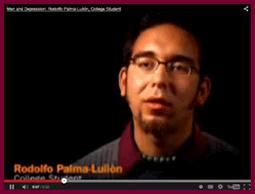
Figure 12: RODOLFO PALMA- LULIÓN "BEING LATINO MAKES IT HARDER, BECAUSE THERE'S THIS SILENCE OVER THINGS" TV PSA
Recovered from: https://youtu.be/BX408OwcL2s?list=PLV9WJDAawyhbo5HInSxkRqTgwM3obv0iz
Figure 13
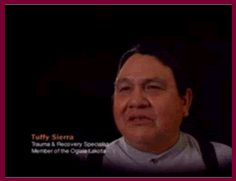
Figure 13: TUFFY SIERRA "DEPRESSION FOR US AS INDIAN MEN IS NOT DIAGNOSED BECAUSE OF THE TRAUMA WE'VE SUFFERED" TV PSA
Recovered from: https://youtu.be/bAraKaiRznE?list=PLV9WJDAawyhbo5HInSxkRqTgwM3obv0iz
The storytelling acts of real men in this campaign counter the social script that discourages men from expressing pain, sensitivity, and seeking help because such behaviors go against traditional masculine role expectations (McCusker & Galupo, 2011, p. 275; Möller-Leimkühler, 2002, p. 3). Rather these men speak of help-seeking as a necessity for dealing with depression, and NIMH constructs the act of asking for help as an act of courage—a trait associated with traditional masculinity. In attempt to target men who are likely to express negative attitudes about help-seeking, the campaign employed men who represent “a peer reference group that can be considered to represent the values that have been socially defined as critical aspects of male identity” and emphasized their masculine qualities (Rochlen et al. (2005).
______One of the reasons that governmentality is so powerful is the role of individuals as self-policing agents when disciplinary technologies are taken up and enacted. In research on governing public health, Brown & Knopp (2010) point out, “In contrast to the state’s sovereign power (the use of physical force, the most extreme instance being the extinguishing of life itself), governmentality refers to more subtle and complex features of the power relationship between citizens and the state” (p. 393). In the process of sharing lived experiences with depression, stories reproduce institutional message about depression while encouraging others to engage in technologies of the self as a cure to this mental health concern. Real men demonstrate the success that comes from taking the initiative to challenge traditional behaviors and engage in self-care practices that include attention to the emotional while simultaneously laying the groundwork for a new masculinity that includes men “dealing with depression” and seeking help rather than ignoring it.
5. Technologies of sociality: Governing through social media
Over a ten year span, the campaign to create awareness around men’s depression has shifted in terms of message delivery. Traditional mass media forms of TV and radio PSAs and print media dominated the early campaign. In 2013, the website was overhauled and social media tools were integrated. Campaign literature and PSAs, once only available in a one to many format through print and mass media outlets, became readily available, accessible, and sharable online [7]. TV and radio spots originally broadcast on public television and hosted on the NIMH website were uploaded to the video sharing site YouTube and linked to the NIMH website (Figure 1). In addition, sharing options via social media icons were integrated onto the website, allowing web users to share on FB, Twitter, Google+, and email (Figure 14).
Figure 14
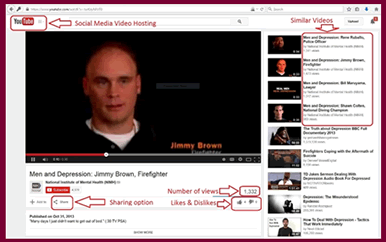
Figure 14: YOUTUBE HOSTED PSA (2016)
Recovered from: https://youtu.be/JurKzyNPzT0?list=PLV9WJDAawyhbo5HInSxkRqTgwM3obv0iz
Social media sites like YouTube and Facebook have become a significant spaces for sharing medical information, with organizations employing these mediated forms to disseminate multimodal representations of health and illness. Research on diabetes-orientated Facebook pages showed how “visual and linguistic features of social intimacy [have been used] to synthesise personal relationships with their audiences and to foster user involvement with their authoring organisations” (Hunt, 2015). The inclusion of new media tools on institutional websites that allow consumers to share, like, comment on, and repost content shifts the role of everyday people from passive recipients of information to active distributors and promoters of ideological messages.
______Media scholar Henry Jenkins (2006) argues that we are in an age of transition, a “convergence culture” in which old and new media interact in a complex relationship, depending on active participation of consumers working in a social dynamic with media producers to influence the relationship among audiences, producers, and content. As government agencies follow trends to integrate social media for information dissemination, everyday people can take on multiple roles as both health consumers and promoters. As seen on print materials and the website, the voices of real men captured as screen shots and sound bites from TV and radio PSAs are used to reproduce institutional discourses. The intertextuality between the NIMH website, TV and radio PSAs, print pamphlets, and social media creates a multifaceted web of ideology dissemination about depression, gender, and health that is intricately embedded in the project of governmentality.
______Trends in social media have shown the power of peer-to-peer communication to provide information, distribute news, and inspire social action. Facebook founder Mark Zuckerberg, in a speech at the United Nations’ General Assembly, predicted that the affordances of this lateral communication form to provide access and allowing sharing of information will be the source of global power redistribution and argued for Internet access as a basic human right in need of global attention (Hempel, 2016). Social control is even more insidious in the digital age as the affordances of social media allow for information to be recirculated and publicly affirmed with greater ease and frequency while also appearing benign. The idea of “social control” takes on a whole new meaning in the digital age. Where once the term inferred that government bodies were the disciplining agent upon the masses, with the increasing power of social media to reproduce ideology, members of society are increasingly becoming the agents of power and control upon one another.
______In the past, the work of governing people was done in a top-down fashion, with experts at the top of the power hierarchy educating the masses. When pamphlets were handed out in print form, information sharing was largely a private exchange between two people. The digital age has shifted the model to a multidirectional system of information circulation and reproduction which is often public. The act of sharing about a topic on one's Facebook page, for example, creates an alignment with an issue through the visible link that is shared and/or tagged and viewable to friends. With social media, governing happens at a peer level, not just top-down. Every day people have the power to share and like and comment on expert ideas in public ways like never before. Social media is part of a historic shift towards greater socialization rather than individuation. New media adds another layer of complexity to governmentality, as people have the power to like and share information with large amounts of people at the touch of a button, or a push, click of the mouse.
6. Conclusion
This case study of the NIMH public service campaign about men's depression shows how accounts of illness are deployed as tools of governmentality to discursively (re)construct notions of mental health and masculinity, with people serving as both products and producers of language (Wetherell & Edley, 1999). The campaign becomes more than a disciplinary technology of power used to control the conduct of the mentally ill and make them docile bodies, but instead is part of a complex set of discursive practices within a system of technologies that simultaneously disciplines individuals and others through circulating therapeutic discourses while teaching them, through such discourse, to manage and discipline themselves for their own good. In concert, these discursive technologies inform citizens about the seriousness of depression and educate men (through modeling self-care practices) to better manage the self. Through this lens, NIMH represents the institutional voice that exerts disciplinary power upon citizens while the individual voices of men telling their stories reflect both technologies of the self (Foucault, 1988) and the strategic re-deployment of disciplinary technologies through social media such that social media intertwines with the disciplinary technologies of the state and the self, with technologies of sociality serving as another disciplinary tool for governing citizens.
References
Addis, M. E. (2008). Gender and Depression in Men. Clinical Psychology: Science & Practice, 15(3), 153–168. Recovered from: http://doi.org/10.1111/j.1468-____________2850.2008.00125.x
Brown, M., & Knopp, L. (2010). Between anatamo- and bio-politics: Geographies of sexual health in wartime Seattle. Political Geography, 29(7), 392–403. Recovered from: ______http://doi.org/10.1016/j.polgeo.2010.10.001
Brownhill, S., Wilhelm, K., Barclay, L., & Schmied, V. (2005). “Big build”: hidden depression in men. Australian & New Zealand Journal of Psychiatry, 39(10), 921–931. ______Recovered from: http://doi.org/10.1111/j.1440-1614.2005.01665.x
Burns, S. M., & Mahalik, J. R. (2011). Suicide and dominant masculinity norms among current and former United States military servicemen. Professional Psychology: ______Research and Practice, 42(5), 347–353. Recovered from: http://doi.org/10.1037/a0025163
Chuick, C. D., Greenfeld, J. M., Greenberg, S. T., Shepard, S. J., Cochran, S. V., & Haley, J. T. (2009). A qualitative investigation of depression in men. Psychology of Men ______& Masculinity, 10(4), 302–313. Recovered from: http://doi.org/10.1037/a0016672
Clarke, J. N. (2009). The portrayal of depression in magazines designed for men (2000-2007). International Journal of Men’s Health, 8(3), 202–212. Recovered from: ______http://doi.org/10.3149/jmh.0803.202
Courtenay, W. H. (2003). Key determinants of the health and well-being of men & boys. International Journal of Men’s Health, 2(1), 1–30.
Foucault, M. (1977). Discipline and punish: the birth of the prison. New York: Pantheon Books.
______. (1988). Technologies of the self: A seminar with Michel Foucault. (L. H. Martin, H. Gutman, & P. H. Hutton, Eds.). Amherst: University of Massachusetts Press.
______. (2003). Society must be defended: Lectures at the Collège de France, 1975-76. (M. Bertani, A. Fontana, F. Ewald, & D. Macey, Eds.). New York: Picador.
______. (2011). The Government of Self and Others: Lectures at the College de France, 1982-1983. Picador.
Foucault, M., Burchell, G., Gordon, C., & Miller, P. (1991). The Foucault effect: studies in governmentality. Chicago: University of Chicago Press. Recovered from: ____________http://www.loc.gov/catdir/description/uchi051/91010456.html http://www.loc.gov/catdir/enhancements/fy0609/91010456-b.html ______________________________http://www.loc.gov/catdir/enhancements/fy0608/91010456-t.html
Fox, N., & Ward, K. (2006). Health identities: from expert patient to resisting consumer. Health: An Interdisciplinary Journal for the Social Study of Health, Illness, and ______Medicine, 10(4), 461–479.
Fragoso, J. M., & Kashubeck, S. (2000). Machismo, gender role conflict, and mental health in Mexican American men. Psychology of Men & Masculinity, 1(2), 87–97. ______Recovered from: http://doi.org/10.1037/1524-9220.1.2.87
Furman, R. (2010). Social work practice with men at risk. New York: Columbia University Press.
Giddens, A. (1991). Modernity and self-identity. Stanford: Stanford University Press.
______. (1992). The transformation of intimacy : sexuality, love, and eroticism in modern societies. Stanford, Calif.: Stanford University Press.
Hammond, W. P. (2012). Taking it like a man: Masculine role norms as moderators of the racial discrimination-depressive symptoms association among African American ______men. American Journal of Public Health, 102(Suppl 2), S232–S241. Recovered from: http://doi.org/10.2105/AJPH.2011.300485
Hempel, J. (2016, January 19). Inside Facebook’s Ambitious Plan to Connect the Whole World. Wired. Recovered from: http://www.wired.com/2016/01/facebook-____________zuckerberg-internet-org/?mbid=nl_12016
Hunt, D. (2015). The many faces of diabetes: A critical multimodal analysis of diabetes pages on Facebook. Language & Communication, 43, 72–86. Recovered from: ______http://doi.org/10.1016/j.langcom.2015.05.003
Iwamoto, D. K., Gordon, D. M., Oliveros, A., Perez-Cabello, M. A., Brabham, T., Lanza, A. S., & Dyson, W. (2012). The role of masculine norms and informal support on ______mental health in incarcerated men. Psychology of Men & Masculinity, 13(3), 283–293. Recovered from: http://doi.org/10.1037/a0025522
Iwamoto, D. K., Liao, L., & Liu, W. M. (2010). Masculine norms, avoidant coping, Asian values, and depression among Asian American men. Psychology of Men & ____________Masculinity, 11(1), 15–24. Recovered from: http://doi.org/10.1037/a0017874
Jakupcak, M., Grossbard, J., Blais, R. K., Garcia, H., & Okiishi, J. (2014). “Toughness” in Association With Mental Health Symptoms Among Iraq and Afghanistan War ______Veterans Seeking Veterans Affairs Health Care. Psychology of Men & Masculinity, 15(1), 100–104. Recovered from: http://doi.org/10.1037/a0031508
Lafrance, M. N. (2007). A Bitter Pill. Journal of Health Psychology, 12(1), 127–140. Recovered from: http://doi.org/10.1177/1359105307071746
Lyotard, J.-F. (1984). The Postmodern Condition. Minneapolis, Minn.: University Of Minnesota Press. Recovered from: https://www.upress.umn.edu/book-division/books/the-
______ postmodern-condition
Machin, D. (2016). The need for a social and affordance-driven multimodal critical discourse studies. Discourse & Society, 27(3), 322–334. Recovered from: ____________http://doi.org/10.1177/0957926516630903
Mahalik, J. R., Good, G. E., & Englar-Carlson, M. (2003). Masculinity Scripts, Presenting Concerns, and Help Seeking: Implications for Practice and Training. Professional ______Psychology: Research and Practice, 34(2), 123–131. Recovered from: http://doi.org/doi:
McCusker, M. G., & Galupo, M. P. (2011). The impact of men seeking help for depression on perceptions of masculine and feminine characteristics. Psychology of Men & ______Masculinity, 12(3), 275–284. Recovered from: http://doi.org/10.1037/a0021071
Möller-Leimkühler, A. M. (2002). Barriers to help-seeking by men: A review of sociocultural and clinical literature with particular reference to depression. Journal of Affective ______Disorders, 71(1–3), 1–9. Recovered from: http://doi.org/10.1016/S0165-0327(01)00379-2
NIHM. (2003). Ser latino — transcript. Retrieved May 28, 2014, from http://www.nimh.nih.gov/health/topics/depression/men-and-depression/public-service-__________________announcements/ser-latino-transcript.shtml
NIMH. (2009). Depression in Men. Retrieved September 12, 2011. Recovered from: http://www.nimh.nih.gov/health/topics/depression/men-and-depression/depression-in-
______men.shtml
NIMH. (2013). Background on Education Materials. Retrieved July 31, 2013. Recovered from: http://www.nimh.nih.gov/health/topics/depression/men-and-
______depression/background-on-education-materials.shtml
Richards, J., Ryan, P., McCabe, M., Groom, G., & Hickie, I. (2011). The influence of mental health education on GPs’ management of depression. In The abstracts of the 38th ______annual conference of the Australian Psychology Society (p. 207). Melbourne, Vic. Recovered from: http://www.deakin.edu.au/dro/view/DU:30013988
Rimke, H. M. (2000). Governing Citizens Through Self-Help Literature. Cultural Studies, 14(1), 61–78. Recovered from: http://doi.org/10.1080/095023800334986
Rochlen, A. B., Whilde, M. R., & Hoyer, W. D. (2005). The Real Men. Real Depression Campaign: Overview, Theoretical Implications, and Research Considerations.
______Psychology of Men & Masculinity, 6(3), 186–194. Recovered from: http://doi.org/10.1037/1524-9220.6.3.186
Santiago-Menendez, M., & Campbell, A. (2013). Sadness and Anger: Boys, Girls, and Crying in Adolescence. Psychology of Men & Masculinity, 14(4), 400–410.
______Recovered from: http://doi.org/10.1037/a0030661
Thompson, R. (2012). Looking healthy: visualizing mental health and illness online. Visual Communication, 11(4), 395–420. Recovered from:
______ http://doi.org/10.1177/1470357212453978
Thurlow, C. (2006). From Statistical Panic to Moral Panic: The Metadiscursive Construction and Popular Exaggeration of New Media Language in the Print Media. Journal of ______Computer-Mediated Communication, 11(3), 667–701. Recovered from: http://doi.org/10.1111/j.1083-6101.2006.00031.x
Thurlow, C., & Mroczek, K. (2011). Digital Discourse: Language in the New Media. Oxford University Press, USA.
Turnbull, J. E. (1991). Depression. In A. Gitterman (Ed.), Handbook of social work practice with vulnerable populations (pp. 165–204). New York: Columbia University Press.
Ussher, J. M. (2010). Are We Medicalizing Women’s Misery? A Critical Review of Women’s Higher Rates of Reported Depression. Feminism & Psychology, 20(1), 9–35. ______Recovered from: http://doi.org/10.1177/0959353509350213
Wetherell, M., & Edley, N. (1999). Negotiating Hegemonic Masculinity: Imaginary Positions and Psycho-Discursive Practices. Feminism & Psychology, 9(3), 335–356.
WHO. (2011). Gender and women’s mental health. Retrieved September 12, 2011. Recovered from: http://www.who.int/mental_health/prevention/genderwomen/en/
___________________
1. This continuing concern with governing emotional well-being can also be seen in the mental hygiene movement of the nineteenth century and the eugenics movement of the twentieth century.
2. A public service announcement (PSA) is one in which no charge is made and which promotes programs, activities, or services of federal, state, or local governments (e.g., recruiting, sale of U.S. Savings Bonds, etc.) or the programs, activities or services of non-profit organizations (e.g., United Way, Red Cross blood donations, etc.) or any other announcements regarded as serving community interests. (p.1)
3. All materials linked to the Men and Depression section of the NIMH website.
4. Narrative vignettes come from hours of unscripted conversations from a wide spectrum of men captured on video while they spoke candidly with other men about their experiences with depression. The men filmed gave permission to use their full names and professions and were active participants in the campaign. (Rochlen et al., 2005).
5. Many of the real men could be said to embody modern day heroes: firefighter, police officer, soldier, and athletic champion.
6. English translation of original TV PSA broadcast in Spanish.
7. Print versions of pamphlets, originally available by mail, are now available as PDF files for download.
|
|















